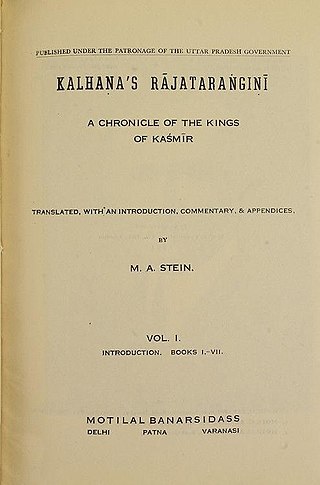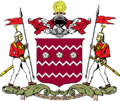
The history of Kashmir is intertwined with the history of the broader Indian subcontinent in South Asia with influences from the surrounding regions of Central, and East Asia. Historically, Kashmir referred to only the Kashmir Valley of the western Himalayas. Today, it denotes a larger area that includes the Indian-administered union territories of Jammu and Kashmir and Ladakh, the Pakistan-administered territories of Azad Kashmir and Gilgit-Baltistan, and the Chinese-administered regions of Aksai Chin and the Trans-Karakoram Tract.
Kalhana was the author of Rajatarangini, an account of the history of Kashmir. He wrote the work in Sanskrit between 1148 and 1149. All information regarding his life has to be deduced from his own writing, a major scholar of which is Mark Aurel Stein.
Shingara, better known as Sultan Sikandar Shah Miri, also by his sobriquet Sikandar Butshikan was the seventh Sultan of Kashmir and a member of Shah Mir dynasty who ruled from 1389 until his death in 1413.

Rājataraṅgiṇī is a metrical legendary and historical chronicle of the north-western part of Indian sub-continent, particularly the kings of Kashmir. It was written in Sanskrit by Kashmiri historian Kalhana in the 12th century CE.
Kota Rani was the last ruler of the Hindu Lohara dynasty in Kashmir. She was also the last female ruler of Kashmir. She was regent for her new husband because of the minority of her son in 1323−1338, and ruled as monarch in 1338−1339. She was deposed by Shah Mir, who became the second Muslim ruler of Kashmir after Rinchan who converted to Islam and ruled as Sultan Sadr-ud-din.

Buddhism was an important part of the classical Kashmiri culture, as is reflected in the Nilamata Purana and Kalhana's Rajatarangini. Buddhism is generally believed to have become dominant in Kashmir in the time of Emperor Ashoka, although it was widespread there long before his time, enjoying the patronage not only of Buddhist rulers but of Hindu rulers too. From Kashmir, it spread to the neighbouring Ladakh, Tibet and China proper. Accounts of patronage of Buddhism by the rulers of Kashmir are found in the Rajatarangini and also in the accounts of three Chinese visitors to Kashmir during 630-760 AD.

The Shah Mir dynasty was a dynasty that ruled the Kashmir Sultanate in the Indian subcontinent. The dynasty is named after its founder, Shah Mir.

Shah Rukh Shahi Khan, popularly known as Ghiyas-ud-Din Zainu'l-Abidin or simply Zainu'l-Abidin, was the ninth Sultan of Kashmir, who reigned first from 1418 to 1419 and then from 1420 to 1470. He was famously called Budshah by his subjects.

Didda, also known as The Catherine of Kashmir, was the last ruler of Utpala dynasty from 980 CE to 1003 CE. She first acted as regent for her son and various grandsons from 958 CE to 980 CE, and from 980 CE as sole ruler and monarch. Most knowledge relating to her is obtained from the Rajatarangini, a work written by Kalhana in the twelfth century.

Sultan Shamsu'd-Din Shah Mir or simply Shamsu'd-Din Shah or Shah Mir was the second Sultan of Kashmir and founder of the Shah Mir dynasty. Shah Mir is believed to have come to Kashmir during the rule of Suhadeva, where he rose to prominence. After the death of Suhadeva and his brother, Udayanadeva, Shah Mir proposed marriage to the reigning queen, Kota Rani. She refused and continued her rule for five months till 1339, appointing Bhutta Bhikshana as prime minister. After the death of Kota Rani, Shah Mir established his own kingship, founding the Shah Mir dynasty in 1339, which lasted till 1561.

Sugandha was the fifth ruler of Kashmir in the northern Indian subcontinent during the 10th century.
Islam is the majority religion practised in Kashmir, with 97.16% of the region's population identifying as Muslims as of 2014. The religion came to the region with the arrival of Mir sayed Ali shah Hamdani, a Muslim Sufi preacher from Central Asia and Persia, beginning in the early 14th century. The majority of Kashmiri Muslims are Sunni Muslims, and Shias account for between 20% and 25% of the Muslim population, who mostly reside in north and central Kashmir. They refer to themselves as "Koshur" in their mother language. Non-Kashmiri Muslims in Kashmir include semi-nomadic cowherds and shepherds, belonging to the 𝙂𝙪𝙟𝙟𝙖𝙧𝙨 and Bakarwal communities.

The Lohara dynasty was a Kashmiri Hindu dynasty that ruled over Kashmir and surrounding regions in the northwestern part of the Indian subcontinent for more than 3 centuries between 1003 CE and approximately 1320 CE. The early history of the dynasty was described in the Rajatarangini, a work written by Kalhana in the mid-12th century and upon which many and perhaps all studies of the first 150 years of the dynasty depend. Subsequent accounts, which provide information up to and beyond the end of the dynasty, come from Jonarāja and Śrīvara. The later rulers of the dynasty were weak; internecine fighting and corruption were endemic during this period, with only brief years of respite, making the dynasty vulnerable to the growth of Islamic conquests in the region.

Tosa Maidan is a tourist destination and a hill station in the khag area of the Budgam district in the Kashmir Valley of the Indian union territory of Jammu and Kashmir. The name also marks the historic Tosa Maidan route into the Kashmir Valley from the Poonch Valley. In fact, the original name of Tosa Maidan appears to have been "Tosa Marg". Mahmud of Ghazni and the Sikh monarch Ranjit Singh attempted to invade the Kashmir Valley via this route following the Battle of Shopian
The Karkota dynasty ruled over the Kashmir valley and some northern parts of the Indian subcontinent during 7th and 8th centuries. Their rule saw a period of political expansion, economic prosperity and emergence of Kashmir as a centre of culture and scholarship.

The Kashmir Sultanate or historically Latinized as Sultanate of Cashmere, was a medieval Indo-Islamic kingdom established in the early 14th century in Northern India, primarily in the Kashmir Valley. The sultanate was founded by Rinchan Shah, a Ladakhi noble who converted from Buddhism to Islam. The sultanate was briefly interrupted by the Loharas until Shah Mir, a councillor of Rinchan, overthrew the Loharas and started his own dynasty. The Shah Mirs ruled from 1339 until they were deposed by the Chak warlords and nobles in 1561. The Chaks continued to rule the sultanate until the Mughal conquest in 1586 and their surrender in 1589.
The Second Gonanda dynasty, was a Kashmiri Hindu dynasty. According to Kalhana, this dynasty ruled Kashmir just before the Karkotas.
SherAshmak commonly known as Shihabu'd-Din Shah Miri, , or simply Shihabu'd-Din Shah, was a ruler from the Shah Mir dynasty based in Kashmir. He was the fifth Sultan of Kashmir who ruled from 1354 to 1373. Shihab is considered to be one of the most powerful kings of Kashmir as his empire extended from Kashgar Ladakh to West Punjab and from Kabul to Chamba.
The Shah Mir–Lohara War, which took place in 1338–1339, was a military conflict between the Royal forces of the Hindu Lohara dynasty and the rebellious Muslim Shah Mir dynasty led by former courtier Shah Mir. It resulted in the overthrowing of the Loharas and the revival of the Kashmir Sultanate.


































